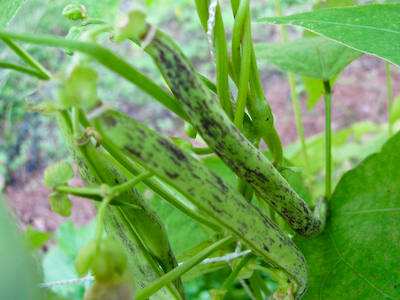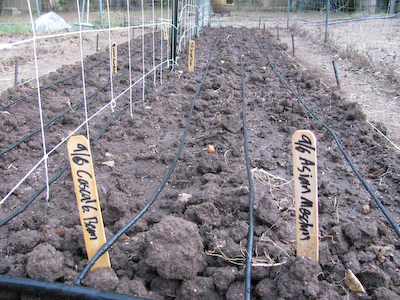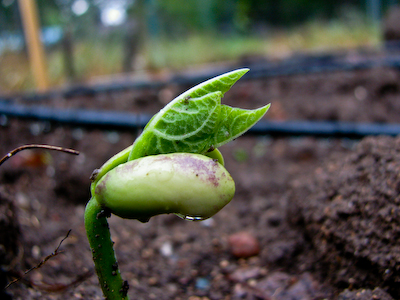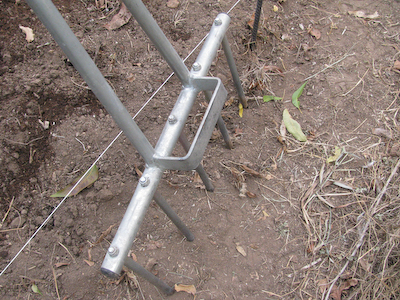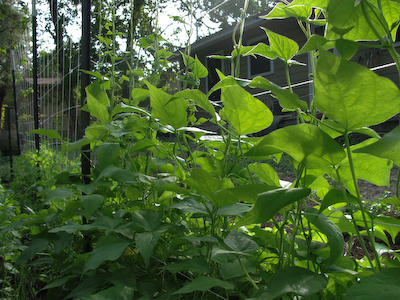After a record hot summer with virtually no rain, this has been a most perfect fall for gardening. Right now I am enjoying sugar snap peas, cilantro, Japanese mustard greens, pole beans and radishes. Broccoli, broccoli raab and tatsoi will be in full production soon.
Cascade pole beans
I use a raised bed gardening system similar to the one presented in the John Jeavons book How to Grow More Vegetables. I learned how to create raised beds through a two year apprenticeship that I did with Bruce Blevins at Nokomis Gardens, East Troy, Wisconsin. Bruce studied under Alan Chadwick shortly before Chadwick’s death. Chadwick brought the “French-intensive” method of gardening to UC Santa Cruz in the late 1960s. Bruce also passed on some of the other aspects of the Chadwick experience by making us learn garden related poetry. One of my favorite passages is from Romeo and Juliet: (Mickle means great):
O, mickle is the powerful grace that lies
In plants, herbs, stones, and their true qualities:
For naught so vile that on the earth doth live
But to the earth some special good doth give;
Nor aught so good but, strain’d from that fair use,
Revolts from true birth, stumbling on abuse:
Virtue itself turns vice, being misapplied;
And vice sometimes by action dignified.
Within the infant rind of this small flower
Poison hath residence, and medicine power:
My garden beds would be better described as deeply dug rather than raised. The top of the bed only reaches a few inches above the surrounding ground and I don’t use any type of structure to contain them. Double digging involves removing a layer of topsoil, loosening the subsoil with a digging fork, and then replacing the topsoil.
Just Planted Bed September 6
Seedling emerging a few days later
Double digging has been criticized for overly working the soil and potentially damaging soil structure. Jeff Lowenfels and Wayne Lewis point out in their book Teaming with Microbes, that excessive tillage can destroy the large formations of soil fungi naturally present in some soils. I take these considerations to heart, but I also find that a one time initial double digging of the east Austin clay soil that I have in my backyard makes a tremendous difference in the productivity of the garden.
I make the beds no wider than I can reach from the pathway, so there is no need to ever step in the beds and re-compact the soil. With successive plantings I find that loosening the soil with a Bio-Fork and a digging fork to be sufficient. The Bio-Fork is a two-handed digging fork with ten inch tines used exclusively for loosening soil. In Noel’s gardening system both potatoes and sweet potatoes play an important role in the crop rotation and by harvesting these vegetables the beds are effectively dug rather deeply.
Bio-Fork
Since I don’t grow anything in the pathways I use a flat shovel to skim off the top two to three inches of topsoil and throw it onto the beds. I use CobraHead® Long Handle to shape the beds and since rainfall is an issue in central Texas, I make a slight lip around the edge. Bruce taught me to be precise about the width of the bed so I use string lines to keep the beds at exactly 50 inches wide. At 6’5″ I could probably make the beds a little wider, but I have stuck with this size. I keep the pathways just wide enough so that I can get in between the beds comfortably without my size 14 boots accidentally trampling my dinner.
Early October
I have recently taken to mulching the pathways between the beds with pine straw. I do this in part for weed control, but mostly to keep my feet from getting muddy when I go out to harvest some greens or herbs when I am cooking.
Raised beds offer many advantages, but one of the biggest is that I get a lot of produce from a compact area, therefore I don’t have to weed or water an extensive area. Given how much that I travel to promote CobraHead garden tools, this really helps me keep my garden from getting out of control.

